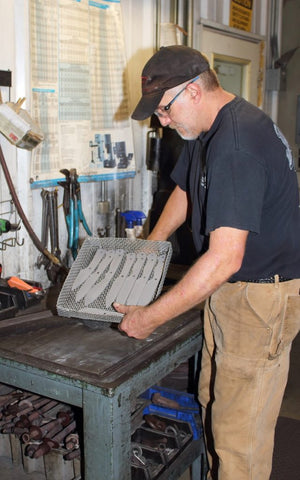A laser engraving on every New West Knifeworks blade proudly reads "USA" but what does that mean, exactly? This series explores the people and processes behind the knives that rewrote the formula for knife production in America.
Traditionally, the knifemaking epicenters of the world have been small towns in places like Japan and Germany, where quality knives have been produced over hundreds of years through intense specialization. According to Corey Milligan, “What makes those places good for making knives lies in the lack of big factories. Instead, little sub-contractors specialize in just one thing, whether that’s polishing the blade, grinding the blade, cutting the profile, making the handles, making the rivet, or making the serration, and each sub contractor is an expert in that one individual thing."
To make quality knives in America, Milligan had to figure out a way to replicate that model at a time when production was either being outsourced or done on a large scale that didn't allow for the level of specialization and expertise he needed.
Through a series of trial and error and even a brief stint of manufacturing blades in Japan, Milligan is proud to add that "USA" laser engraving to his knives, knowing that he is creating jobs close to home and able to quality control and innovate easily. Seven out of the twelve steps in the knifemaking process actually take place in the New West Knifeworks factory in Victor, Idaho, but before the blades arrive there, Milligan relies on a series of specialists who are the best in the world at what they do, just like traditional knife makers always have.
First, the raw material, a high-grade steel, is made at Crucible Industries (read about the best knife steel in the world here.) Then, the steel goes to Niagra Speciality Metals in New York, where it is hot rolled and flattened in a high-tech rolling mill into usable sheets. Then, the sheets travel to Schrock Metal Products for laser profile cutting.



The highest grade knife steel in the world goes through a three-step process at Niagra Speciality Metals, rendering the material usable and ready for heat treating.
Then, the steel travels to Pennsylvania to Peter’s Heat Treating, the family-owned industry leaders in a crucial step in the knife-making process: heat must be applied to the steel to strengthen it for everyday use. According to Milligan, “The heat treat and steel come together to make the magic. You have to have the perfect steel and it has to be perfectly heat treated to get the full performance and value from the steel.”
The heating process itself is actually quite intensive– the steel must be heated and cooled a total of 15 times, each time raising the hardness of the steel and changing the molecular structure so that it can hold an edge. This same process is applied by Peter's Heat Treating to metal parts that go in nuclear reactors, on airplanes and bridges, and in John Deer tractors: places where strength and reliability of material is non negotiable. This same finishing step that is used by NASA is also used for New West knives, which might seem like overkill but is actually a beautiful celebration of quality, American innovation and craftsmanship. Plus, military-grade steel comes in handy when you use your knife every day for your entire life.

Peter's Heat Treating processes blades for custom knives. This process includes straightening, double tempering, cryo treating and hardness testing.
By the time the blades arrive at the New West Factory in Victor, Idaho, they are perfect blank canvases to transform into usable works of art: stay tuned for a look inside the brand new factory and the in-house process that makes these knives both Made in America and made to last.
